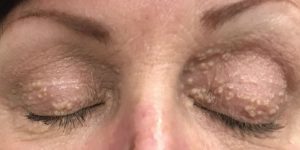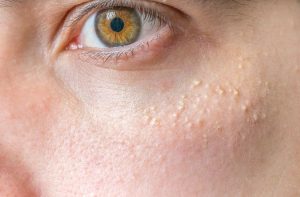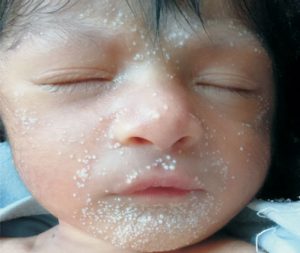
Milia often misspelled as Milialar is a common dermatological condition characterized by small, white, or yellowish cysts that typically appear on the skin’s surface.
What is a Milia or Milium cyst?
Milia, also known as Milium Cyst (singular), are tiny cysts that manifest as small, white or yellowish bumps on the skin’s surface. These cysts occur when keratin, a protein found in the outer layer of skin, becomes trapped beneath the surface, forming a raised lesion. Milia can affect individuals of all ages and skin types, and while they are generally harmless, they can be aesthetically bothersome.
They are most commonly found on the face, especially around the eyes, nose, and cheeks. Milia can also occur on other parts of the body, such as the torso and genitals. Milia cysts are harmless and not painful. They usually go away on their own within a few weeks or months. However, if they are bothering you or do not go away on their own, there are a few treatment options available.
Also Read: Bed Bug Bites – All You Need to Know
[ez-toc]
Symptoms of Milia (Milialar)
The main symptom of milia is the presence of small, white bumps on the skin. These bumps are usually hard and painless. They can appear in groups or clusters, and they are most commonly found on the face, especially around the eyes, nose, and cheeks. Milia can also occur on other parts of the body, such as the torso and genitals.
Other symptoms of milia may include:
Redness or inflammation around the bumps: This is more common in milia that are caused by skin conditions or blistering diseases.
Itching: Milia are not usually itchy, but they may become itchy if they are irritated.
Pain: Milia are not usually painful, but they may become painful if they are infected.
If you have any of these symptoms, it is important to see a dermatologist to get a diagnosis and discuss treatment options.
Symptoms of Milialar in Newborn Babies
Milia in newborn babies are very common and usually go away on their own within a few weeks or months. However, if the milia are bothering your baby or do not go away on their own, be sure to see a pediatrician.
Symptoms of milia in newborn babies may include:
- Small, white bumps on the face, especially around the eyes, nose, and cheeks: The bumps may be hard or soft, and they are usually painless.
- Redness or inflammation around the bumps: This is more common in milia located on the eyelids.
- Itching: Milia in newborn babies are not usually itchy, but they may become itchy if they are irritated.
Facts About Milia

- Appearance and Color:
- Milia appear as small, firm, raised lesions on the skin.
- They are usually white or yellowish in color, giving them a distinct appearance.
- The cysts are often pearly or translucent, making them stand out against the surrounding skin.
- Size and Texture:
- Milia typically range in size from pinpoint dots to about 1-2 millimeters in diameter.
- They have a smooth, rounded surface and may resemble small beads or pearls.
- The texture of milia is firm and often described as being hard to the touch.
- Location:
- Milia most commonly occurs on the face, especially around the eyes, nose, cheeks, and forehead.
- They can also develop on other areas of the body, including the neck, chest, upper back, and genitalia.
- Grouping and Distribution:
- Milia can appear individually or in clusters.
- In infants, milia are often seen on the nose, cheeks, and forehead, and they may be present at birth or develop shortly after.
- In adults, milia may be more widespread and tend to cluster in specific areas.
- Painlessness:
- Milia are typically painless and not associated with itching or discomfort.
- They do not cause redness or inflammation in the surrounding skin.
- Persistence:
- While milia often resolve on their own over time, they can persist for extended periods, ranging from weeks to months or even years.
- Occurrence in Specific Populations:
- Neonatal Milia: Milia commonly appears in newborns and are often temporary. They usually resolve within a few weeks after birth.
- Primary Milia in Adults: These milia often affect older children and adults, appearing as isolated or scattered cysts.
- Secondary Milia: These can occur at any age and are often associated with skin trauma, burns, blistering, or certain skin conditions.
Types of Milia?
Milia are small, benign cysts that typically manifest as tiny, white or yellowish bumps on the skin’s surface. They can be broadly classified into several types based on their etiology, age of occurrence, and location on the body. Here are the main types of milia:
Neonatal Milia

This type appears in newborns and is often referred to as “baby acne” due to its resemblance to acne. It commonly occurs on the face, especially the nose, cheeks, and forehead. Neonatal milia typically resolve on their own within a few weeks after birth.
Primary Milia in Adults: These milia occur in older children and adults. They are usually scattered and may appear on the face, particularly around the eyes, cheeks, and forehead. Primary milia may also be seen on the mucous membranes of the mouth.
Secondary Milia: Secondary milia result from trauma or damage to the skin. They may arise due to conditions that cause damage to the sweat ducts or hair follicles, obstructing the natural shedding of skin cells. Common causes include burns, blistering, sun damage, dermatological procedures, and certain skin conditions.
Milia en Plaque: Milia en plaque is a rare form of milia characterized by a grouping of milia that form a raised, flat patch on the skin. It often occurs on the eyelids and is more prevalent in middle-aged women.
Multiple Eruptive Milia: Multiple eruptive milia is an uncommon form of milia in which numerous milia develop over a short period, often within weeks or months. The are characterized by the sudden appearance of multiple small, white cysts on the face, arms, and chest. Multiple eruptive milia can be itchy and may be associated with underlying medical conditions, such as kidney disease or certain medications.
Traumatic Milia: Traumatic milia develops at sites of injury or trauma to the skin, such as a burn, blister, or surgery. Traumatic milia are usually small and white, but they can sometimes be larger and darker in color. Traumatic milia usually go away on their own within a few weeks or months.
Milia en Plaque of the Genitals: Milia en plaque of the genitals is a rare condition characterized by the development of milia in the genital area. It is more common in women and can be associated with underlying skin conditions.
Multiple Milia Syndrome: Multiple milia syndrome is a rare genetic disorder that leads to the formation of numerous milia, both on the skin and inside the mouth. This condition is also known as Haber’s syndrome.
Understanding the different types of milia is important for accurate diagnosis and appropriate management. Treatment options may vary based on the type, location, and underlying causes of milia. A dermatologist can provide a comprehensive evaluation and recommend suitable treatment strategies based on the specific type of milia.
Treatments for Milia
Milia usually goes away on their own within a few weeks or months. However, if they are bothering you or do not go away on their own, there are a few treatment options available. Treatment primarily focuses on removing the existing milia and preventing their recurrence. Here are detailed treatments for milia:
Topical Retinoids:
Topical retinoids, such as tretinoin, adapalene, and tazarotene, are derivatives of vitamin A and are commonly used to treat milia. They work by promoting cell turnover and stimulating the exfoliation of dead skin cells, helping to clear pores and prevent new milia from forming. It is essential to follow your dermatologist’s instructions regarding the application and concentration of the retinoid, as they can cause skin irritation if not used correctly.
Physical Extraction:
Physical extraction of milia involves a dermatologist using a sterile needle or scalpel to create a tiny incision in the skin, allowing for the milium’s contents (keratin and dead skin cells) to be manually extracted. This procedure should only be performed by a trained healthcare professional to minimize the risk of infection and scarring.
Cryotherapy:
Cryotherapy involves using liquid nitrogen to freeze the milia, causing them to blister and eventually fall off. This treatment is typically quick and effective, and it’s a suitable option for those with multiple milia or if other treatments haven’t been successful.
Chemical Peels:
Chemical peels utilize alpha hydroxy acids (AHAs), beta hydroxy acids (BHAs), or other chemical agents to exfoliate the skin. Peels can help in removing the top layer of skin, including milia, and promote skin regeneration. However, these peels should only be performed by a dermatologist or licensed skincare professional.
Microdermabrasion:
Microdermabrasion is a non-invasive procedure that uses a device to exfoliate the top layer of skin, helping to unclog pores and remove milia. It’s a relatively gentle option, but multiple sessions may be needed for optimal results.
Laser Therapy:
Various laser treatments, such as CO2 laser or erbium laser, can be used to resurface the skin and remove milia. Laser therapy can target the milia directly, breaking down the cyst and promoting healing.
Diathermy:
Diathermy involves the use of an electric current to heat and cauterize the milia, allowing the contents to be released. This treatment is typically performed by a dermatologist.
Lancing:
In this procedure, a dermatologist uses a sterile needle or lancet to puncture the milium and extract its contents. After lancing, the skin is usually cleaned and dressed to prevent infection.
Prescription Creams:
In some cases, a dermatologist may prescribe a customized cream or lotion that combines ingredients like retinoids, alpha hydroxy acids, and antibiotics to target milia and prevent their recurrence.
Proper Skin Care:
Preventing milia from forming or recurring involves maintaining a good skincare routine. This includes gentle cleansing, using non-comedogenic products, and regular exfoliation to prevent the buildup of dead skin cells.
It’s crucial to consult a dermatologist before undergoing any treatment to determine the most appropriate approach based on the type, location, and extent of milia. Additionally, following post-treatment care and maintaining good skincare practices can aid in preventing the formation of new milia and optimizing treatment outcomes.
Preventing milia cysts or Milialar
There is no guaranteed way to prevent milia cysts, but there are a few things you can do to reduce your risk:
Wash Your Face Regularly: Wash your face twice a day with a gentle cleanser. Avoid using harsh soaps or scrubs, as these can irritate your skin and make milia cysts more likely to form.
Use a Mild Moisturizer: Apply a mild moisturizer to your face after washing. This will help to keep your skin hydrated and reduce the risk of milia cysts forming.
Avoid Using Heavy Makeup: Heavy makeup can clog your pores and make milia cysts more likely to form. If you do choose to wear makeup, be sure to remove it thoroughly at the end of the day.
Exfoliate Regularly: Exfoliating regularly can help to remove dead skin cells and reduce the risk of milia cysts forming. You can exfoliate once or twice a week with a mild exfoliator.
Milia or Milialar as wrongly spelled is a common dermatological condition characterized by small, white, or yellowish cysts that can be aesthetically bothersome. Understanding its etiology, clinical manifestations, diagnosis, and treatment options is essential for effective management and improved quality of life for affected individuals. Prevention through proper skin care practices is also key in minimizing the development and recurrence of milia. Further research is warranted to deepen our understanding of this condition and refine treatment approaches.